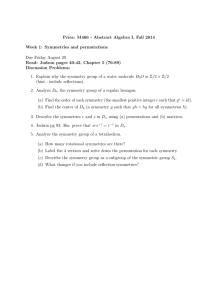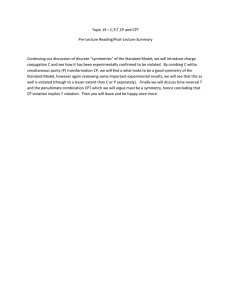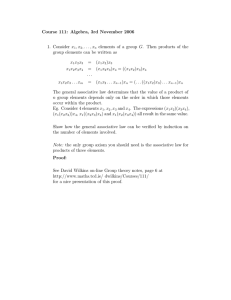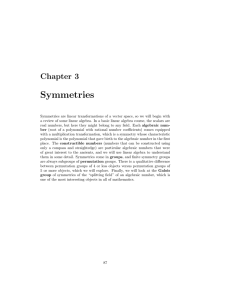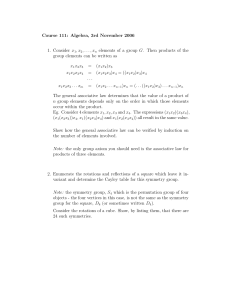Symmetry Breaking in Quantified Boolean Formulae
advertisement
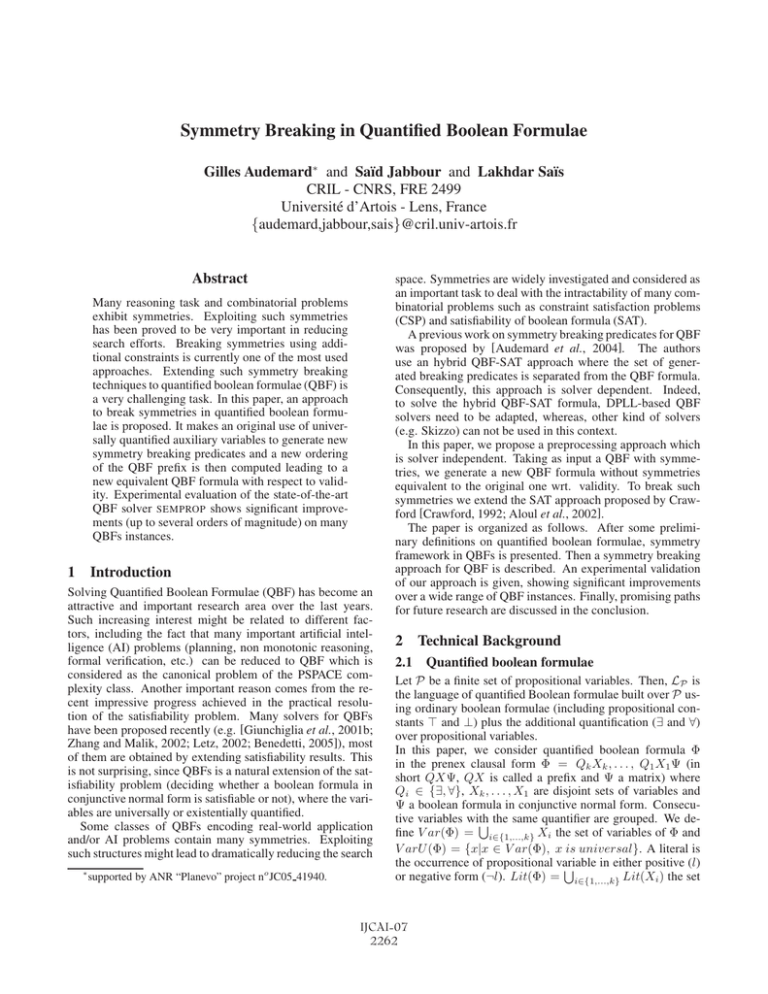
Symmetry Breaking in Quantified Boolean Formulae
Gilles Audemard∗ and Saı̈d Jabbour and Lakhdar Saı̈s
CRIL - CNRS, FRE 2499
Université d’Artois - Lens, France
{audemard,jabbour,sais}@cril.univ-artois.fr
Abstract
Many reasoning task and combinatorial problems
exhibit symmetries. Exploiting such symmetries
has been proved to be very important in reducing
search efforts. Breaking symmetries using additional constraints is currently one of the most used
approaches. Extending such symmetry breaking
techniques to quantified boolean formulae (QBF) is
a very challenging task. In this paper, an approach
to break symmetries in quantified boolean formulae is proposed. It makes an original use of universally quantified auxiliary variables to generate new
symmetry breaking predicates and a new ordering
of the QBF prefix is then computed leading to a
new equivalent QBF formula with respect to validity. Experimental evaluation of the state-of-the-art
QBF solver SEMPROP shows significant improvements (up to several orders of magnitude) on many
QBFs instances.
1 Introduction
Solving Quantified Boolean Formulae (QBF) has become an
attractive and important research area over the last years.
Such increasing interest might be related to different factors, including the fact that many important artificial intelligence (AI) problems (planning, non monotonic reasoning,
formal verification, etc.) can be reduced to QBF which is
considered as the canonical problem of the PSPACE complexity class. Another important reason comes from the recent impressive progress achieved in the practical resolution of the satisfiability problem. Many solvers for QBFs
have been proposed recently (e.g. [Giunchiglia et al., 2001b;
Zhang and Malik, 2002; Letz, 2002; Benedetti, 2005]), most
of them are obtained by extending satisfiability results. This
is not surprising, since QBFs is a natural extension of the satisfiability problem (deciding whether a boolean formula in
conjunctive normal form is satisfiable or not), where the variables are universally or existentially quantified.
Some classes of QBFs encoding real-world application
and/or AI problems contain many symmetries. Exploiting
such structures might lead to dramatically reducing the search
∗
supported by ANR “Planevo” project no JC05 41940.
space. Symmetries are widely investigated and considered as
an important task to deal with the intractability of many combinatorial problems such as constraint satisfaction problems
(CSP) and satisfiability of boolean formula (SAT).
A previous work on symmetry breaking predicates for QBF
was proposed by [Audemard et al., 2004]. The authors
use an hybrid QBF-SAT approach where the set of generated breaking predicates is separated from the QBF formula.
Consequently, this approach is solver dependent. Indeed,
to solve the hybrid QBF-SAT formula, DPLL-based QBF
solvers need to be adapted, whereas, other kind of solvers
(e.g. Skizzo) can not be used in this context.
In this paper, we propose a preprocessing approach which
is solver independent. Taking as input a QBF with symmetries, we generate a new QBF formula without symmetries
equivalent to the original one wrt. validity. To break such
symmetries we extend the SAT approach proposed by Crawford [Crawford, 1992; Aloul et al., 2002].
The paper is organized as follows. After some preliminary definitions on quantified boolean formulae, symmetry
framework in QBFs is presented. Then a symmetry breaking
approach for QBF is described. An experimental validation
of our approach is given, showing significant improvements
over a wide range of QBF instances. Finally, promising paths
for future research are discussed in the conclusion.
2 Technical Background
2.1
Quantified boolean formulae
Let P be a finite set of propositional variables. Then, LP is
the language of quantified Boolean formulae built over P using ordinary boolean formulae (including propositional constants and ⊥) plus the additional quantification (∃ and ∀)
over propositional variables.
In this paper, we consider quantified boolean formula Φ
in the prenex clausal form Φ = Qk Xk , . . . , Q1 X1 Ψ (in
short QXΨ, QX is called a prefix and Ψ a matrix) where
Qi ∈ {∃, ∀}, Xk , . . . , X1 are disjoint sets of variables and
Ψ a boolean formula in conjunctive normal form. Consecutive variables with
the same quantifier are grouped. We define V ar(Φ) = i∈{1,...,k} Xi the set of variables of Φ and
V arU (Φ) = {x|x ∈ V ar(Φ), x is universal}. A literal is
the occurrence of propositional variable
in either positive (l)
or negative form (¬l). Lit(Φ) = i∈{1,...,k} Lit(Xi ) the set
IJCAI-07
2262
of complete literals of Φ, where Lit(Xi ) = {xi , ¬xi |xi ∈
Xi }. The set of literals are encoded using integer numbers
i.e. the positive (resp. negative) literal l (resp. ¬l) is associated to a positive number α (resp. −α). Then, we define |l|
as the absolute value of l.
For a given variable x ∈ V ar(Φ) st. x ∈ Xk , we define
rank(x) = k. Variables appearing in the same quantifier
group are equally ranked.
2.2
Symmetries in Quantified Boolean Formulae
Let Φ = Q1 X1 , . . . , Qm Xm Ψ be a QBF and σ a permutation over the literals of Φ i.e. σ : Lit(Φ) → Lit(Φ).
The permutation σ on Φ is then defined as follows: σ(Φ) =
Q1 σ(X1 ), . . . , Qm σ(Xm )σ(Ψ). For example, if Ψ is in
clausal form then σ(Ψ) = {σ(c)|c ∈ Ψ} and σ(c) =
{σ(l)|l ∈ c}.
Definition 1 Let Φ = Q1 X1 , . . . , Qm Xm Ψ be a quantified
boolean formula and σ a permutation over the literals of Φ.
σ is a symmetry of Φ iff
1. ∀x ∈ Lit(Φ), σ(¬x) = ¬σ(x)
2. σ(Φ) = Φ i.e σ(Ψ) = Ψ and ∀i ∈ {1, . . . , m} σ(Xi ) =
Xi .
Let us note that each symmetry σ of a QBF Φ is also a symmetry of the boolean formula Ψ. The converse is not true. So
the set of symmetries of Φ is a subset of the set of symmetries
of Ψ.
A symmetry σ can be seen as a list of cycles (c1 . . . cn )
where each cycle ci is a list of literals (li1 . . . lini ) st. ∀1 ≤
k < ni , σi (lik ) = lik+1 and σi (lini ) = li1 . We define |σ| =
ci ∈σ |ci | where |ci | is the number of literals in ci .
It is well known that breaking all symmetries might lead in
the general case to an exponential number of clauses [Crawford et al., 1996]. In this paper, for efficiency and clarity reasons, we only consider symmetries with binary cycles. Our
approach can be extended to symmetries with cycles of arbitrary size.
Detecting symmetries of a boolean formula is equivalent to the graph isomorphism problem [Crawford, 1992;
Crawford et al., 1996] (i.e. problem of finding a one to one
mapping between two graphs G and H). This problem is not
yet proved to be NP-Complete, and no polynomial algorithm
is known. In our context, we deal with graph automorphism
problem (i.e. finding a one to one mapping between G and G)
which is a particular case of graph isomorphism. Many programs have been proposed to compute graph automorphism.
Let us mention NAUTY [McKay, 1990], one of the most efficient in practice.
Recently, Aloul et al. [Aloul et al., 2002] proposed an
interesting technique that transforms CNF formula Ψ into
a graph GΨ where vertices are labeled with colors. Such
colored vertices are considered when searching for automorphism on the graph (i.e. vertices with different colors can not
be mapped with each others).
In [Audemard et al., 2004], a simple extension to QBFs
formulae is given. Such extension is simply obtained by introducing a different color for each set of vertices whose literals belong to the same quantifier group. In this way, literals
from different quantifier groups can not be mapped with each
others (see the second condition of the definition 1). Then,
to detect such symmetries, NAUTY is applied on the graph
representation of the QBF.
3 Breaking symmetries in QBFs
Symmetry breaking has been extensively investigated in the
context of constraint satisfaction and satisfiability problems.
The different approaches proposed to break symmetries can
be conveniently classified as dynamic and static schemes.
Dynamic breaking generally search and break symmetries using breaking predicates or not [Benhamou and Sais, 1994;
Gent and Smith, 2000]. Static breaking schemes refer to techniques that detect and break symmetries in a preprocessing
step. For SAT, symmetries are generally broken by generating additional constraints, called symmetry breaking predicates (SBP) [Crawford, 1992; Aloul et al., 2002]. Such SBP
eliminates all models from each equivalence class of symmetric models, except one. However, in the general case, the
set of symmetry predicates might be of exponential size. In
[Aloul et al., 2002], Aloul et al extend the approach of Crawford [Crawford, 1992] by using group theory and the concept
of non-redundant generators, leading to a considerable reduction in the SBP size.
We briefly recall the symmetry breaking technique introduced by Crawford in [Crawford et al., 1996]. Let Ψ be a
CNF formula and σ = {(x1 , y1 ) . . . (xn , yn )} a symmetry of
Ψ. The SBP associated to σ is defined as follows:
x1 ≤ y1
(x1 = y1 ) → x2 ≤ y2
...
(x1 = y1 ) . . . (xn−1 = yn−1 ) → xn ≤ yn
The SBP defined above expresses that, when for all i ∈
{1 . . . k − 1} xi and yi are equivalent (get the same truth
value) and xk is true, then yk must be assigned to true. This
reasoning can be extended to QBF provided that the symmetry follows the prefix ordering.
3.1
Motivation
In the following example, we show the main difficulty behind
the extension of SAT symmetry breaking predicates (SBP) to
QBFs.
Example 1 Let Φ = ∀x1 y1 ∃x2 y2 Ψ1 be a QBF where Ψ =
(x1 ∨ ¬x2 ) ∧ (y1 ∨ ¬y2 ) ∧ (¬x1 ∨ ¬y1 ∨ x2 ∨ y2 ). The permutation σ1 = {(x1 , y1 )(x2 , y2 )} is a symmetry of Φ. Breaking
the symmetry σ1 using the traditional approach, induces the
following SBP : (¬x1 ∨ y1 ) ∧ (¬x1 ∨ ¬x2 ∨ y2 ) ∧ (y1 ∨
¬x2 ∨ y2 ). As the clause (¬x1 ∨ y1 ) is universally quantified,
the new obtained QBF by adding the SBP to the original
QBF leads to an invalid QBF formula.
To overcome this main drawback, in addition to the classical SBP , new breaking predicates (called QSBP ) are generated for symmetries containing at least one universal cycle
(see definition 3). In such a case, some variables become existentially quantified. These variables will be associated to
new additional universally quantified variables. There relationships are expressed in the generated QSBP . To safely
IJCAI-07
2263
add such QSBP to the original QBF formula, a new prefix
ordering is computed.
After a formal presentation of our approach for a single
symmetry, a generalization to arbitrary set of symmetries is
then described.
3.2
Breaking a single symmetry
Now, we formally introduce our approach for breaking symmetries in QBF.
Definition 2 Let Φ = Q1 X1 . . . Qi Xi . . . Qm Xm Ψ be a
QBF and σ a symmetry of Φ. We define σ ↑ Xi as the subsequence of the symmetry σ restricted to the cycles involving
variables from Xi . Then, the symmetry σ can be rewriten
following the prefix ordering as {σ1 . . . σi . . . σm } such that
σi = σ ↑ Xi . When σ respect the prefix ordering, it is called
p-ordered.
In the sequel, symmetries are considered to be p-ordered.
Example 2 Let Φ = ∃x2 y2 ∀x1 y1 ∃x3 y3 (¬x1 ∨ y1 ∨ x3 ) ∧
(x1 ∨ ¬x2 ∨ y3 )(x1 ∨ x2 ∨ x3 ) ∧ (¬x3 ∨ ¬y3 ) ∧ (x1 ∨ x2 )(x1 ∨
y2 ) ∧ (¬x1 ∨ ¬y1 ∨ ¬x2 ∨ ¬y2 ) Φ has a symmetry σ =
{(x1 , y1 )(x2 , y2 )(x3 , y3 )}. Reordering σ with respect to the
prefix leads to σ = {σ1 , σ2 , σ3 } st. σ1 = σ ↑ X1 = (x2 , y2 ),
σ2 = σ ↑ X2 = (x1 , y1 ), σ3 = σ ↑ X3 = (x3 , y3 ).
Definition 3 Let Φ be a QBF, σ a symmetry of Φ and c =
(x, y) is a cycle of σ. We define x (resp. y) as an in-literal
(resp. out-literal). A cycle c is called universal if x and y are
universally quantified. A symmetry σ is called universal if it
contains at least one universal cycle, otherwise it is called
existential.
For existential symmetries of a QBF, classical SBP [Crawford et al., 1996] can be translated linearly to a CNF formula thanks to new additional variables. The obtained set
of clauses can be added to the QBF matrix while preserving
its validity. The main problem arises when breaking universal
symmetries (see example 1). Indeed, to safely break universal
symmetries while keeping the classical SBP, we first reorder
the symmetry variables belonging to the same universal quantifier group. This new ordering allows us to determine literals
to be likely implied from the SBP. Secondly, as implied universal literals lead to the invalidity of the QBF, an original
approach is then proposed to deal with such literals. In the
following, the problem behind universal implied literals is illustrated and our approach is then motivated.
Let σ = {(x1 , y1 ), . . . , (xk , yk ), . . . } be a universal symmetry of a given QBF Φ where (xk , yk ) is a universal cycle. As
mentioned above, σ is ordered according to the prefix of Φ.
Suppose xi and yi for 1 ≤ i ≤ k − 1 are assigned the same
truth value, if xk is assigned to true then the universal literal
yk is implied from the SBP. To avoid such a case, the universal quantifier of yk is substituted with an existential quantifier. However, when xi and yi are assigned to different truth
values or xk is assigned to false, yk must remain universally
quantified. To manage these two cases, a new universal variable yk is then introduced. This variable plays the same role
as yk in the second case whereas in the first case it becomes
useless. The relation between the two variables is expressed
using new predicates (called qsbp(σ(yk ))).
Definition 4 Let σ = {c1 . . . ck . . . cn } st. ck = (xk , yk ),
1 ≤ k ≤ n be a universal symmetry. We define QSBP (σ) =
∪{qsbp(σ(yk )), 1 ≤ k ≤ n st. yk is universal} as the
QSBP associated to σ. QSBP (σ) is built using the two
following steps:
1. Adding auxiliary variables : For each universal cycle
ck = (xk , yk ) ∈ σ, we associate a new universal variable yk to the out-literal yk and the universal quantifier
of yk is substituted with an existential quantifier.
2. Generating new predicates :
• if (x1 , y1 ) is a universal cycle st. |x1 | =
|y1 | then
qsb(σ(y1 )) = {¬x1 → (y1 ↔ y1 )}
• ∀k > 1, if (xk , yk ) is a universal cycle then
qsbp(σ(yk )) is made of the following constraints
– ¬xk → (yk ↔ yk ) when |xk | = |yk |
– ((¬xj ∧ yj ) → (yk ↔ yk )), ∀j st. 1 ≤ j < k
Example 3 Let us consider the QBF Φ given in example 1.
The symmetry σ of Φ contains one universal cycle (x1 , y1 ).
Using definition 4, a new variable y1 is associated to the
variable y1 which becomes existentially quantified. Then
QSBP(σ)= qsbp(σ(y1 ))= (¬x1 → (y1 ↔ y1 ))
As described above, to generate the QSBP new variables
are introduced. In the sequel, we describe how such variables
are integrated in the QBF prefix.
Definition 5 Let Φ = Q1 X1 . . . Qm Xm Ψ be a QBF, and
σ = {σ1 . . . σj . . . σm } be a universal symmetry. Let j st.
Qj = ∀ and σj = σ ↑ Xj = {(x1 , y1 ) . . . (xn , yn )}
and Y = {y1 . . . yn } the set of new variables associated
to {y1 . . . yn } respectively. We define the new ordering of
V ar(σj ) ∪ Y as follows : rank(xk ) < rank(yk ) <
rank(yk ) st. 1 ≤ k ≤ n.
We define Gσj (V, A) as the precedence graph associ
ated to σj with V =
1≤k≤n {xk , yk , yk } and A =
{ 1≤k≤n {(xk , yk ), (yk , yk )}}.
To rewrite the quantifier group Qj Xj of the QBF formula
(see definition 6), a new ordering is derived by applying topological sort algorithm on the precedence graph. Let us note
that such a graph is acyclic. In figure 1, the graph representation of σj = σ ↑ Xj is illustrated. The ordering x1 . . . xn
y1 . . . yn y1 . . . yn is then considered.
- y
y1
1
6
- y
y2
...
2
6
x
1
x2
yn
6
-
yn
xn
Figure 1: Graph representation of σj
Definition 6 Let Φ = Q1 X1 . . . Qm Xm Ψ be a QBF, σ =
{σ1 . . . σm } a universal symmetry and for j ∈ {1 . . . m}
σj = σ ↑ Xj = {(x1 , y1 ), . . . (xn , yn )}. Every quantifier
group Qj Xj of Φ is rewritten :
• if Qj = ∀ and σ ↑ Xj = ∅ then
Qpj Xjp = ∀(Xj \V ar(σj ))x1 . . . xn ∃α∀y1 . . . yn ∃y1 . . . yn
IJCAI-07
2264
(see figure 1) st. Xjp = Xj ∪ {y1 . . . yn } and α is a new
variable.
• otherwise Qpj Xjp = Qj Xj
Φ is then rewritten as
p
Ψ ∧ SBP ∧ QSBP
ΦS = Qp1 X1p . . . Qpi Xip . . . Qpm Xm
Remark 1 In definition 6, a new variable α is introduced to
constrain the set of variables {x1 , . . . xn } to be assigned before {y1 , . . . , yn }.
Property 1 Let Φ be a QBF and σ a symmetry of Φ, then Φ
is valid iff ΦS is valid.
To sketch the proof of property 1, we consider the QBF given
in the example 1. Applying our approach on Φ, we obtain the
QBF :
Φs = ∀x1 ∃α∀y1 ∃y1 x2 y2 Ψ1 ∧ (¬x1 ∨ y1 ) ∧ (¬x1 ∨ ¬x2 ∨
y2 ) ∧ (y1 ∨ ¬x2 ¬y2 ) ∧ (x1 ∨ y1 ∨ ¬y1 ) ∧ (x1 ∨ ¬y1 ∨ y1 )
When x1 is assigned to the value true, from the clause
(¬x1 ∨ y1 ) we deduce that y1 is true. If x1 is assigned the
value f alse, the original universal variable y1 is deduced by
substitution (y1 and y1 are equivalent) thanks to the added
constraint ¬x1 → (y1 ↔ y1 ). As rank(y1 ) < rank(y1 ), we
only need to substitute all occurrences of y1 by y1 .
3.3
Breaking all symmetries
Generating QSBP
When considering several symmetries, we can not eliminate
them independently by processing each single symmetry using the single symmetry breaking approach described in section 3.2. One needs to consider the interactions between the
different symmetries. Indeed, considering an universal outliteral yk and its associated new variable yk , the qsbp(σ(yk ))
express the conditions under which such literals yk and yk
are equivalent. As only one variable yk is introduced for
each universal out-literal yk , when yk appears in several symmetries, the different conditions leading to such equivalence
need to be combined.
Definition 7 Let Φ be a QBF, and σ
=
{(x1 , y1 ) . . . (xi , y) . . . }. σ = {(z1 , w1 ) . . . (zj , y) . . . } two
symmetries of Φ with y an universal out-literal. The qsbp’s
associated to y with respect to σ and σ can be written in the
following form (see definition 4) :
• qsbp(σ(y)) = {α1 → (y ↔ y )) . . . αN → (y ↔ y )}
• qsbp(σ (y)) = {β1 → (y ↔ y ) . . . βM → (y ↔ y )}.
We define a binary correlation operator η between σ and σ as follows :
η(σ(y), σ (y)) = {(α1 ∧ β1 ) → (y ↔ y ) . . . (α1 ∧ βM ) →
(y ↔ y ) . . . (αN ∧ β1 ) → (y ↔ y ) . . . (αN ∧ βM ) → (y ↔
y )}.
Definition 8 Let S = {σ 1 . . . σn } be a set of symmetries of
a given QBF and y is universal literal. We define,
• S[y] = {σ j |∃(x, y) ∈ σ j } = {σ 1 . . . σ|S[y]| }.
• qsbp(S[y]) = η(η . . . η(σ 1 , σ 2 ) . . . , σ|S[y]| ) . . . ).
Definition 9 Let S = {σ 1 . . . σn } be the set of symmetries of
a given QBF Φ = QX Ψ. The new QBF matrix ΨS is defined
as follows:
Ψ∧(
SBP (σ i )) ∧ (
1≤i≤n
qsbp(S[x]))
x∈V arU(Φ)
Prefix ordering
Let us now show how a new QBF prefix is built when considering a set of symmetries (for a single symmetry see definition 6). For a set of symmetries {σ 1 , . . . , σn }, we consider
for each universal quantifier group Qk Xk , all the projections
σ i ↑ Xk for each symmetry σ i . The new quantifier group
Qpk Xkp is obtained from the precedence graph representation
of all these projections. Let us recall that each symmetry σ i
is considered p-ordered. Additionally, to avoid cycles from
the graph representation of {σ i ↑ Xk |1 ≤ i ≤ n}, each projection σ i ↑ Xk is considered lexicographically ordered.
Definition 10 Let σ = {(x1 , y1 ), . . . , (xn , yn )} be a set of
cycles. σ is called lexicographically ordered (lex-ordered in
short), iff xi > 0, xi ≤ |yi | 1 ≤ i ≤ n and xi < xi+1
1≤i<n
Example 4 Let Φ
=
Q1 X1 . . . Qm Xm Ψ be a
σ ↑
QBF, σ and σ two symmetries of Φ st.
X1 = {(x2 , x1 )(¬x3 , ¬x4 )(x5 , x6 )}, σ ↑ X1 =
{(x3 , x1 )(x2 , ¬x6 )} and Q1 = ∀. With respect to lexicographical order, σ ↑ X1 = {(x1 , x2 )(x3 , x4 )(x5 , x6 )}
and σ ↑ X1 = {(x1 , x3 )(x2 , ¬x6 )} Figure 2
shows the precedence graph representation of both
σ ↑ X1 and σ ↑ X1 . Applying topological sort
P
is then rewritten as
algorithm, the quantifier QP
1 X1
P
P
Q1 X1 = ∀x1 x5 ∃α∀x2 x3 ∃x2 x3 ∀x4 x6 ∃x4 x6
x5
x2
> x1 Z
Z
Z
~ x
Z
3
-
x2
x3
-
?
x6
-
x4
-
x6
-
x4
Figure 2: Precedence graph of σ ↑ X1 and σ ↑ X1
Dealing with universal cycles of the form (y, x) and
(z, ¬x)
To preserve the equivalence (wrt. validity) between the original QBF and the new generated one, let us now address the
last problem arising from the interactions between the different symmetries. As illustrated in the following example, the
problem arises for symmetries where a universally quantified
out-literal x appears both positively (x) and negatively (¬x).
Example 5 Let Φ = Q1 X1 . . . Qi Xi . . . Qm Xm Ψ be a QBF,
σ and σ two symmetries of Φ st. σ ↑ Xi = {(x1 , y2 )} and
σ ↑ Xi = {(x2 , ¬y2 )}, Qi = ∀.
Using our approach the quantifier group Qi Xi is rewritten
as ∀(Xi \V ar(σ, σ ))∀x1 x2 ∃α∀y2 ∃y2 . The generated SBP
for σ contains the clause c = (¬x1 ∨ x4 ). For σ its corresponding SBP contains the clause c = (¬x2 ∨ ¬y2 ). As
the universal variable x4 is substituted with an existential
one, applying the Q-resolution rule [Kleine-Büning et al.,
IJCAI-07
2265
1995] on c and c leads to a universally quantified resolvent
r = (¬x1 ∨ ¬x2 ). Consequently, the new obtained QBF is
invalid. Finding a new ordering which avoid this problem is
a very challenging task. In example 5, such a problem can
be avoided by considering the new ordering x1 < y2 < x2
instead of the used lex-ordering. Another possible solution,
actually under investigation is to apply composition between
symmetries. More precisely, if we consider σ ◦ σ ◦ σ we
obtain a new symmetry σ = (x1 , ¬x2 ). If in addition to σ
and σ , we also consider σ , then the previous resolvent generated using Q-resolution is now not universally quantified.
Indeed, as x2 is an out-literal, its universal quantifier is substituted with an existential one. Then the resolvent r contains
a literal ¬x2 whose associated variable is existentially quantified. Finally, the quantifier group Qi Xi can be rewritten as
Qpi Xip = ∀x1 ∃α∀x2 ∃x2 ∀y2 ∃y2 .
The above discussion gives us an idea on how to solve in
the general case, the problem arising from symmetries with
universal cycles of the form (y, x) and (z, ¬x). In this paper,
such a problem is simply avoided using the following restriction :
Definition 11 Let Φ = Q1 X1 . . . Qm Xm Ψ be a QBF,
y ∈ V arU (Φ) and S the set of symmetries of Φ. We
define S[y] ↓ y = {σ ↓ y|σ ∈ S[y]}.
For
σ = {(x1 , y1 ), . . . , (xk , yk ) . . . , (xn , yn )}, we define σ↓
yk = {(x1 , y1 ), . . . , (xk−1 , yk−1 )}. The restriction of S
wrt. y is defined as rt(S, y) = {σ|σ ∈ S, σ[y] =
∅, σ[¬y] = ∅} ∪ S[y] ∪ S[¬y]↓{¬y}. For the set of
variables V arU (Φ) = {v1 , . . . , v|V arU(Φ)| }, we define
rt(S, V arU (Φ)) = rt(. . . rt(S, v1 ), v2 ) . . . v|V arU(Φ)| ) . . . )
Note that if S[y] = ∅ or S[¬y] = ∅, then rt(S, y) = S. Naturally, for a given set of symmetries S, the new QBF formula
is generated using rt(S, V arU (Φ)). In this way the obtained
formula is equivalent wrt. validity to the original one.
Complexity
Let σ be a symmetry of a QBF and CN F (QSBP (σ)) the
CNF representation of QSBP (σ). The worst case spacial
complexity of CN F (QSBP (σ)) is in O(|σ|2 ). Considering
σ = {σ1 , . . . , σn } with σi = (xi , yi ), 1 ≤ i ≤ n, the worst
case is reached whenall cycles of σ are universal. In this
case, QSBP (σ) = 1≤i≤n qsbp(σi (yi )). |QSBP (σ)| =
2(i − 1) +
1≤i≤n |qsbp(σ(yi ))|. |qsbp(σ(yi ))| is equal to 2 = 2i (see definition 4). Then, |QSBP (σ)| = 1≤i≤n 2i
which is equal to n(n + 1). More interestingly, using the
same new variables introduced for CN F (SBP ), the size of
QSBP (σ) becomes linear. Unfortunately, because of the
correlations between different symmetries, the QSBP associated to a set of symmetries is exponential in the worst case.
In practice, on all the considered QBF instances, the number of applied correlations (definition 7) does not exceed 3.
Consequently, the QSBP is most often of reasonable size.
4 Experiments
The experimental results reported in this section are obtained on a Xeon 3.2 GHz (2 GB RAM) and performed
on a large panel of symmetric instances (619) available
from [Giunchiglia et al., 2001a]. This set of QBF instances contains different families like toilet, k *, FPGA,
qshifter. As a comparison, we run the state-of-the-art
DPLL-like solver SEMPROP [Letz, 2002] on QBF instances
with and without breaking symmetries. The time limit is fixed
to 900 seconds. Results are reported in seconds. The symmetry computation time (including detection and QSBP generation) is not reported (less than one second in most cases).
1000
100
10
1
0.1
0.01
0.01
0.1
Figure 3:
1
SEMPROP
10
100
1000
comparison
The scatter plot (in log scale) given in figure 3 illustrate the
comprative results of SEMPROP [Letz, 2002] on each QBF
instance Φ and ΦS respectively. The x-axis (resp. y-axis)
corresponds to the cpu time tx (resp. ty) obtained by SEM PROP on Φ (resp. ΦS ). Each dot with (tx, ty) coordinates,
corresponds to a QBF instance. Dots above (resp. below) the
diagonal indicate instances where the original formula Φ is
solved faster i.e. tx < ty (resp. slower i.e. tx > ty) than the
QBF formula ΦS .
Figure 3 clearly shows the computational gain obtained using symmetry breaking predicates (about 167 instances are
solved more efficiently). In some cases the gain is up to 2 orders of magnitude. Of course, there exists some instances
where breaking symmetries decreases the performances of
SEMPROP (about 50 instances). On the remaining instances,
the performance of the solver remains the same with or without breaking symmetries.
Table 1 provides more detailed results on the different QBF
families. The second column (N B) represents the number of
instances in each family. The third column (U ) indicates if
the instances contain universal symmetries (Y ) or not (N ).
For each family, S and T T represents the total number of
solved instances and the total run-time needed for solving all
the instances (900 seconds are added for each unsolved one)
respectively.
As we can see, table 1 gives us more comprehensive results with respect to each family. First, breaking symmetries
significantly improves SEMPROP performances on many QBF
families leading to more solved instances (18 instances). Secondly, the existence of universal symmetries seems to be an
important factor for reducing the search time. Not surprisingly, we have also noticed that symmetries between literals
occurring in the innermost quantifier group are useless. Indeed, such symmetries does not lead to a great reduction in
IJCAI-07
2266
ΦS
Φ
family
fpga
blackbox
scholl
toilet c
k path
qshifter
tipdiam
asp
TOILET
term1
strategic
k branch
k lin
k grz
k poly
toilet a
NB
8
23
32
53
40
6
76
104
7
6
100
42
21
37
42
22
TOTAL
619
U
Y
Y
Y
Y
Y
Y
Y
Y
Y
Y
N
N
N
N
N
N
S
6
1
17
51
28
6
30
104
6
6
86
21
5
23
42
22
TT
1834
19801
13687
2656
12915
67
41455
789
988
174
13482
20096
14553
15242
2031
12
S
7
8
18
53
34
6
30
104
6
6
86
21
5
24
42
22
TT
921
13668
13595
49
7999
61
41459
1909
926
177
13477
20069
14551
14997
2068
20
454
159789
472
145940
Table 1: Results on different QBF families
the search tree, since their corresponding variables are assigned last i.e. the formula is considerably reduced by the
previous assignments. Finally, for QBF families containing
only existential symmetries, breaking them do not improves
the search time. On k branch, k lin, toilet a families containing only existential symmetries, no improvement is observed. Most of these instances correspond to the dots near
the diagonal (see figure 3).
5 Conclusion
Workshop on Tractable Reasonning, AAAI, pages 17–22,
1992.
[Gent and Smith, 2000] I. Gent and B. Smith. Symmetry
breaking in constraint programming. In Proceedings of
ECAI, pages 599–603, 2000.
[Giunchiglia et al., 2001a] E. Giunchiglia, M. Narizzano,
and A. Tacchella. Quantified Boolean Formulas satisfiability library (QBFLIB), 2001.
[Giunchiglia et al., 2001b] E. Giunchiglia, M. Narizzano,
and A. Tacchella. QuBE : A system for deciding Quantified Boolean Formulas Satisfiability. In Proceedings of
IJCAR, 2001.
[Kleine-Büning et al., 1995] H. Kleine-Büning, M. Karpinski, and A. Flögel. Resolution for quantified boolean formulas. Information and computation, 117(1):12–18, 1995.
[Letz, 2002] R. Letz. Lemma and model caching in decision
procedures for quantified boolean formulas. In Proceedings of Tableaux, pages 160–175, 2002.
[McKay, 1990] B. McKay. nauty user’s guide (version 1.5).
Technical report, 1990.
[Zhang and Malik, 2002] L. Zhang and S. Malik. Towards a
symmetric treatment of satisfaction and conflicts in quantified boolean formula evaluation. In Proceedings of the
CP, pages 200–215, 2002.
In this paper, a new approach to break symmetries in QBF
formulae is proposed. Using universally quantified auxiliary
variables, new symmetry breaking predicates are generated
and safely added to the QBF formula. Experimental results
show that breaking symmetries leads to significant improvements of the state-of-the-art QBF solver SEMPROP on many
classes of QBF instances. These experimental results suggest
that for QBF instances containing universal symmetries, significant improvements are obtained. As future works, we plan
to investigate the problem arising from the presence of both
positive and negative out-literal in the set of symmetries.
References
[Aloul et al., 2002] F. Aloul, A. Ramani, I. Markov, and
K. Sakallah. Solving difficult instances of boolean satisfiability in the presence of symmetry. Technical report,
University of Michigan, 2002.
[Audemard et al., 2004] G. Audemard, B. Mazure, and
L. Sais. Dealing with symmetries in quantified boolean
formulas. In proceedings of SAT, 2004.
[Benedetti, 2005] M. Benedetti. sKizzo: a Suite to Evaluate
and Certify QBFs. In Proc. of CADE, 2005.
[Benhamou and Sais, 1994] B. Benhamou and L. Sais.
Tractability through symmetries in propositional calculus.
Journal of Automated Reasoning, 12(1):89–102, 1994.
[Crawford et al., 1996] J. Crawford, M. Ginsberg, E. Luck,
and A. Roy. Symmetry-breaking predicates for search
problems. In proceedings of KR, pages 148–159. 1996.
[Crawford, 1992] J. Crawford. A theorical analysis of reasoning by symmetry in first order logic. In Proceedings of
IJCAI-07
2267


